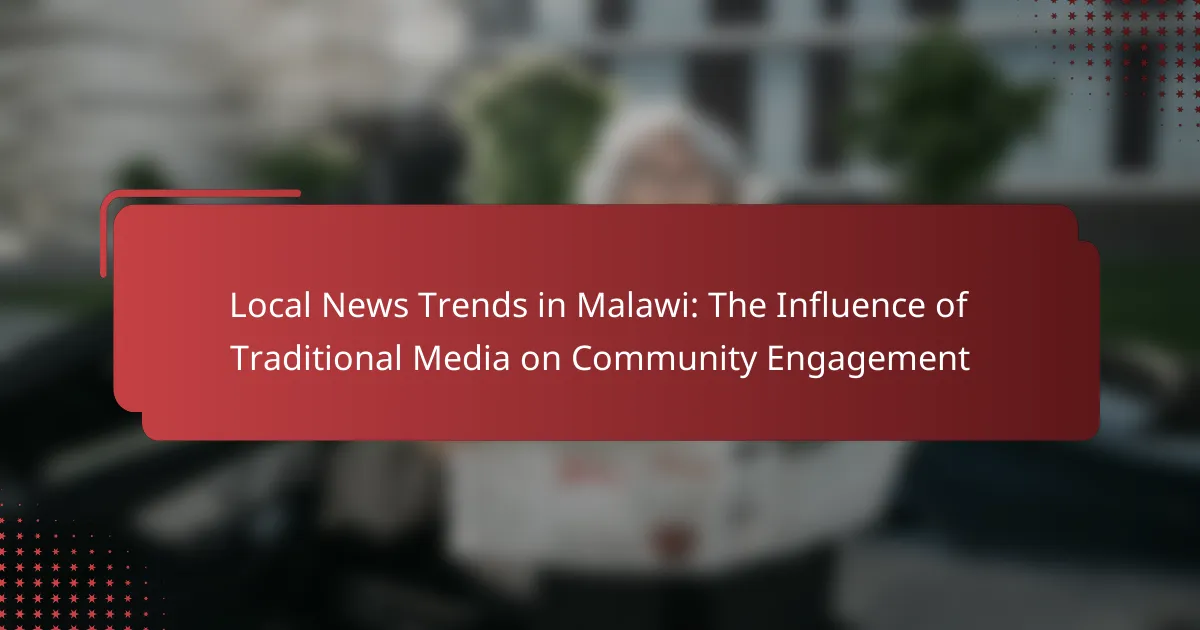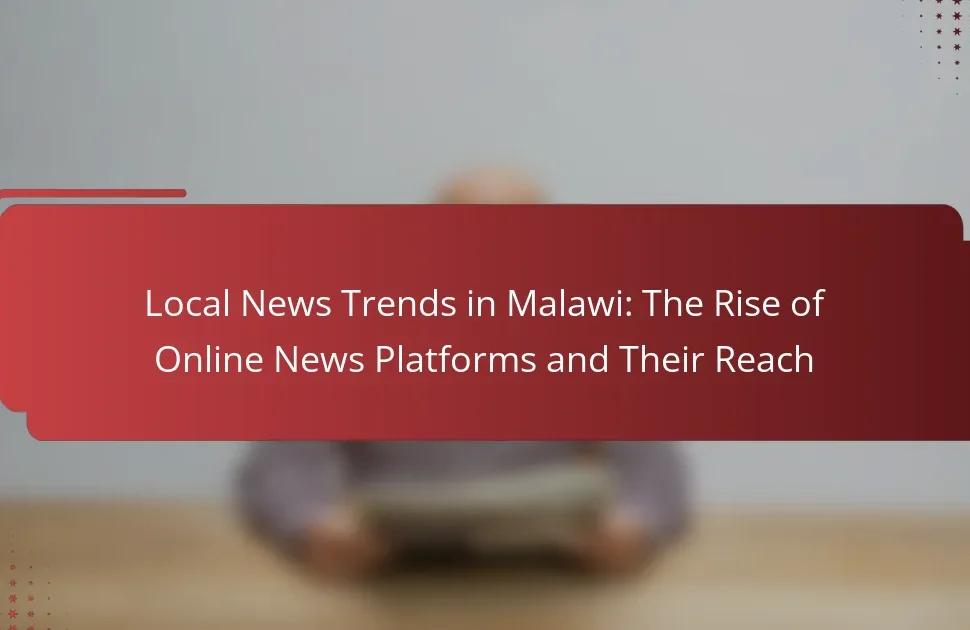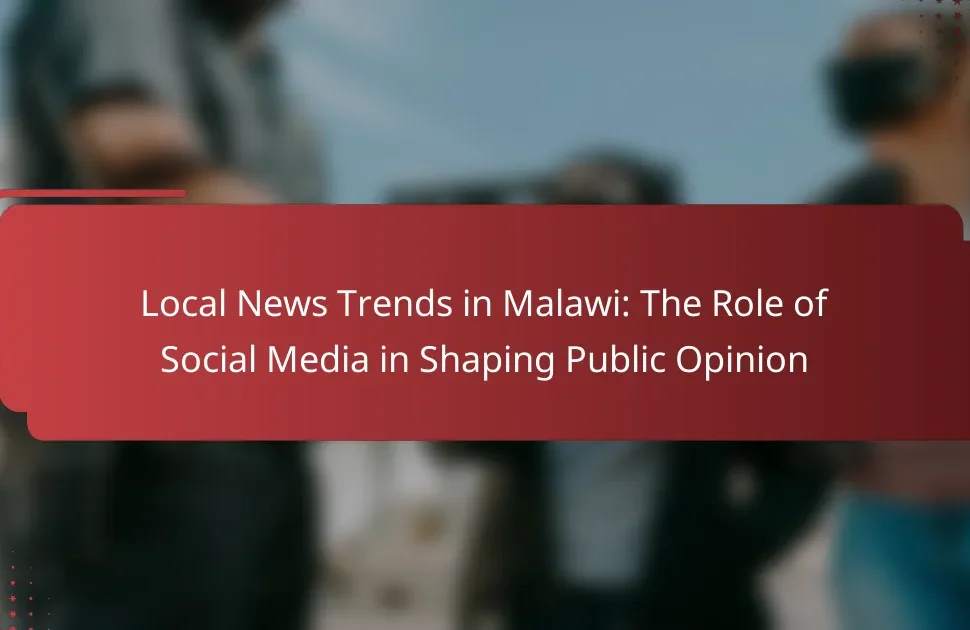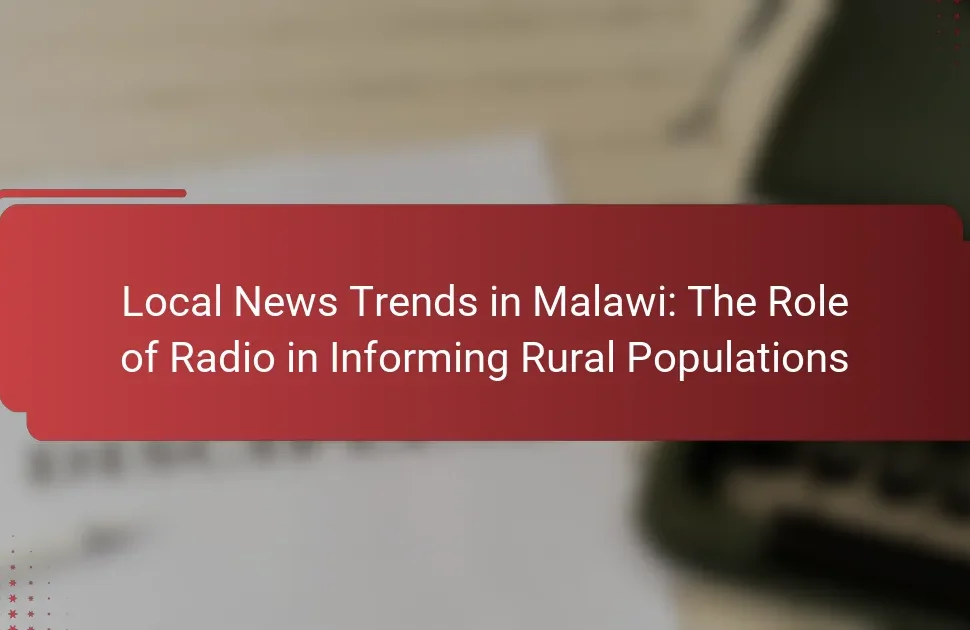The article examines local news trends in Malawi, highlighting the shift towards digital media consumption while acknowledging the continued significance of traditional media, such as radio and newspapers. It discusses the impact of changing audience preferences, particularly among younger demographics, and the dominance of local issues like agriculture, health, and governance in the news landscape. Challenges faced by traditional media, including limited technology access, economic constraints, and political interference, are outlined. The article emphasizes the importance of community engagement in local news through active participation and collaboration with news outlets, demonstrating that increased interaction can enhance trust in media coverage.
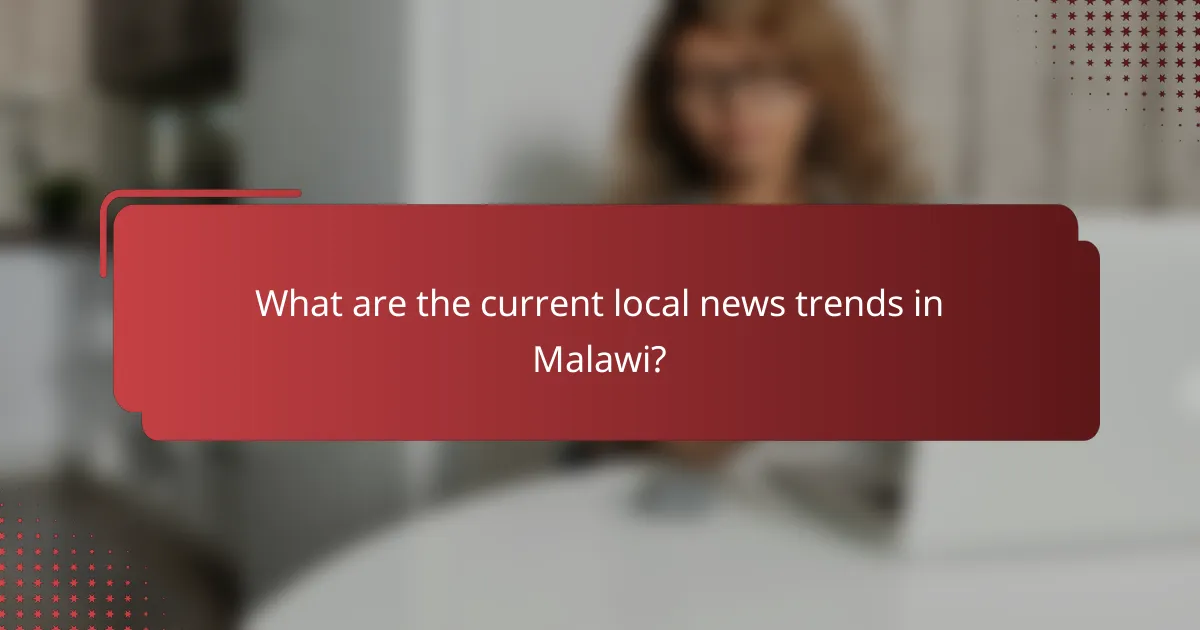
What are the current local news trends in Malawi?
Current local news trends in Malawi include a rise in digital media consumption. Traditional media, such as radio and newspapers, still play a significant role. However, more people are accessing news through social media platforms. This shift reflects changing preferences among younger demographics. Local issues like agriculture, health, and governance dominate the news landscape. Community engagement is increasing as citizens participate in discussions online. The government’s response to COVID-19 has also influenced news coverage. Overall, the media landscape is evolving with technology and audience demands.
How has traditional media shaped these trends?
Traditional media has significantly shaped local news trends in Malawi by providing a platform for community engagement. Radio broadcasts, for example, reach remote areas and inform citizens about important local issues. Newspapers offer in-depth analysis and coverage of regional events, fostering public discourse. Traditional media also serves as a bridge between the government and the community, facilitating dialogue and accountability. According to the Malawi Communications Regulatory Authority, over 80% of Malawians access news through traditional media sources. This widespread reach enhances awareness and participation in local governance. Thus, traditional media plays a crucial role in shaping community engagement trends in Malawi.
What are the key forms of traditional media in Malawi?
The key forms of traditional media in Malawi include radio, newspapers, and community theater. Radio is the most widely consumed medium, with many households relying on it for news and entertainment. Newspapers provide written content and analysis, although their reach is more limited compared to radio. Community theater serves as a platform for storytelling and disseminating information in local languages, engaging audiences directly. These traditional media forms play a significant role in shaping public opinion and community engagement in Malawi.
How do these forms of media influence public perception?
Traditional media influences public perception by shaping narratives and framing issues. These media forms often determine what information is prioritized and how it is presented. For instance, local news can highlight specific community concerns, affecting public awareness and engagement. Research indicates that media representation can sway public opinion on social issues. A study by the Media Institute of Southern Africa found that local news coverage significantly impacts citizens’ perceptions of governance in Malawi. This demonstrates the powerful role traditional media plays in influencing community attitudes and behaviors.
Why is community engagement important in local news?
Community engagement is crucial in local news because it fosters trust and relevance between media and the audience. Engaged communities are more likely to consume and share local news. This interaction enhances the quality of reporting by providing journalists with insights into community needs and priorities. For instance, local news outlets that involve residents in discussions often report higher audience satisfaction. Studies show that when communities feel represented, they are more likely to support local journalism financially and through participation. This symbiotic relationship strengthens democracy by ensuring diverse voices are heard and addressed in local narratives.
What role does traditional media play in fostering community engagement?
Traditional media plays a crucial role in fostering community engagement by providing a platform for local voices. It facilitates the dissemination of information that is relevant to community issues. Traditional media includes newspapers, radio, and television, which reach diverse demographics. These media outlets often cover local events, initiatives, and concerns, encouraging public discussion.
Research shows that community members feel more connected when they are informed about local matters. For instance, a study by the Pew Research Center found that 70% of people believe local news helps them engage with their community. Traditional media also serves as a bridge between local governments and residents, promoting transparency. By highlighting community achievements and challenges, traditional media fosters a sense of belonging and active participation.
How do local news trends affect community participation?
Local news trends significantly influence community participation by shaping public awareness and engagement. When local news highlights community events, residents are more likely to attend and participate. Research indicates that increased coverage of local issues correlates with higher civic involvement. For instance, a study by the Pew Research Center found that communities with robust local news outlets saw up to 20% more voter turnout. Furthermore, local news can foster a sense of belonging and community identity, encouraging residents to engage in local initiatives. Overall, the focus and framing of local news directly impact how community members interact and participate in their neighborhoods.
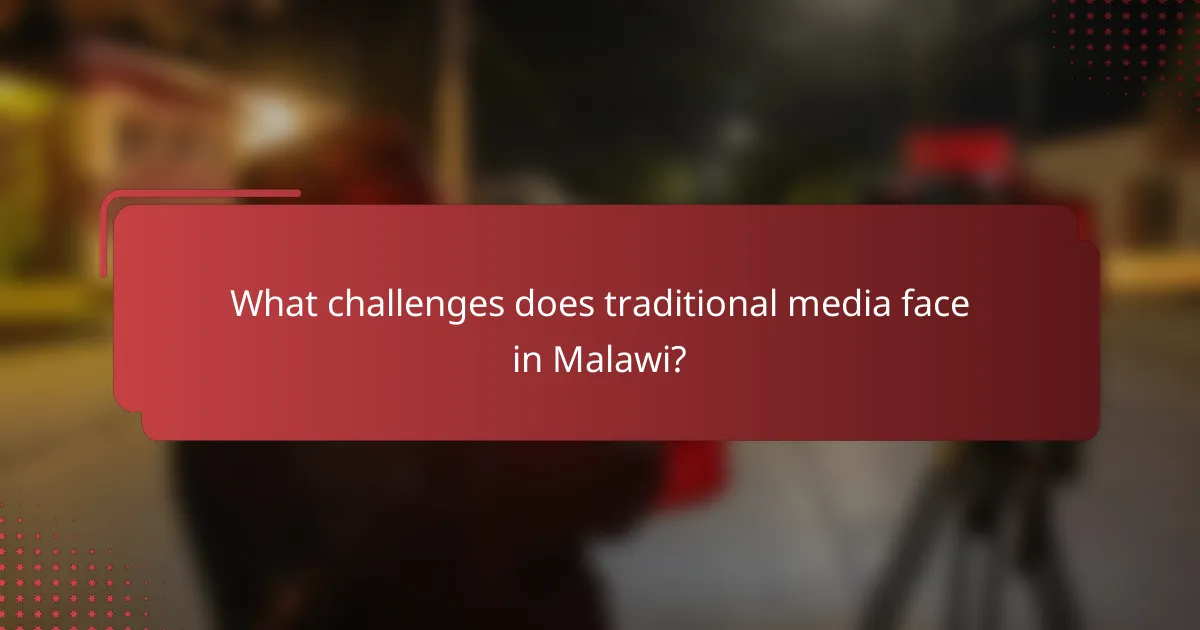
What challenges does traditional media face in Malawi?
Traditional media in Malawi faces several significant challenges. Limited access to technology restricts the reach of traditional media outlets. Many citizens rely on radio and print, which can be less effective in remote areas. Economic constraints hinder advertising revenues for media houses. This reduces their ability to invest in quality journalism and staff. Political interference often compromises editorial independence. Journalists face threats and harassment, impacting their ability to report freely. Additionally, competition from digital platforms attracts audiences away from traditional media. These factors collectively undermine the effectiveness of traditional media in engaging local communities.
How do these challenges impact community engagement?
Challenges such as misinformation and limited access to reliable news sources significantly impact community engagement. Misinformation can create distrust among community members. This leads to reduced participation in local initiatives and events. Limited access to reliable news sources prevents residents from being informed about important issues. Consequently, this hampers their ability to engage in meaningful discussions. Research indicates that communities with better access to accurate information have higher engagement levels. For example, a study by the Media Institute of Southern Africa found that accurate local news increases civic participation. Therefore, addressing these challenges is crucial for enhancing community engagement in Malawi.
What are the limitations of traditional media in reaching diverse audiences?
Traditional media has significant limitations in reaching diverse audiences. It often relies on a one-size-fits-all approach. This approach fails to address the specific needs and preferences of various demographic groups. Traditional media channels, such as television and radio, may not provide content in multiple languages. This language barrier can alienate non-native speakers. Additionally, traditional media may lack representation of minority voices. This underrepresentation can lead to a disconnect with diverse communities. Studies show that media content often reflects the dominant culture, sidelining minority perspectives. Furthermore, traditional media has limited interactivity, reducing audience engagement. The lack of feedback mechanisms can hinder understanding of audience needs. These factors collectively restrict the effectiveness of traditional media in connecting with a broad range of audiences.
How can traditional media adapt to changing community needs?
Traditional media can adapt to changing community needs by actively engaging with local audiences. This includes conducting regular surveys to understand community interests and preferences. Additionally, traditional media can incorporate feedback mechanisms, allowing audiences to voice their concerns and suggestions. Collaborating with local organizations can enhance content relevance and foster community trust. Utilizing digital platforms can also help reach wider audiences and provide timely updates. According to a 2021 study by the Malawi Communications Regulatory Authority, 70% of Malawians prefer news that addresses local issues. This highlights the necessity for traditional media to focus on hyper-local content to remain relevant.
What opportunities exist for enhancing local news engagement?
Opportunities for enhancing local news engagement include leveraging digital platforms and social media. These tools can reach wider audiences and facilitate real-time interaction. Community-driven content creation encourages local voices and perspectives. Collaborations with local organizations can enhance credibility and trust. Hosting community events fosters direct engagement and dialogue. Utilizing multimedia formats attracts diverse audience preferences. Tailoring content to local interests increases relevance and engagement. Data analytics can inform content strategies and audience preferences.
How can traditional media leverage technology for better outreach?
Traditional media can leverage technology for better outreach by utilizing digital platforms and social media. These channels enhance audience engagement and expand reach beyond traditional broadcasting. For instance, radio stations in Malawi can stream content online to attract listeners globally. Social media allows for real-time interaction with audiences, fostering community discussions. Additionally, mobile apps can deliver news alerts directly to users, increasing accessibility. Data analytics can help media outlets understand audience preferences, tailoring content accordingly. This approach has been shown to improve audience retention and attract younger demographics.
What partnerships can strengthen community ties through local news?
Partnerships between local news organizations and community groups can strengthen community ties. Collaboration with schools fosters media literacy and civic engagement. Partnerships with local businesses can support local journalism financially and promote community events. Nonprofit organizations can provide valuable content and resources for local news outlets. Additionally, alliances with government agencies can enhance transparency and accountability in reporting. Research shows that these collaborations increase community participation and trust in local news. For example, a study by the Knight Foundation found that engaged communities are more likely to support local journalism initiatives.
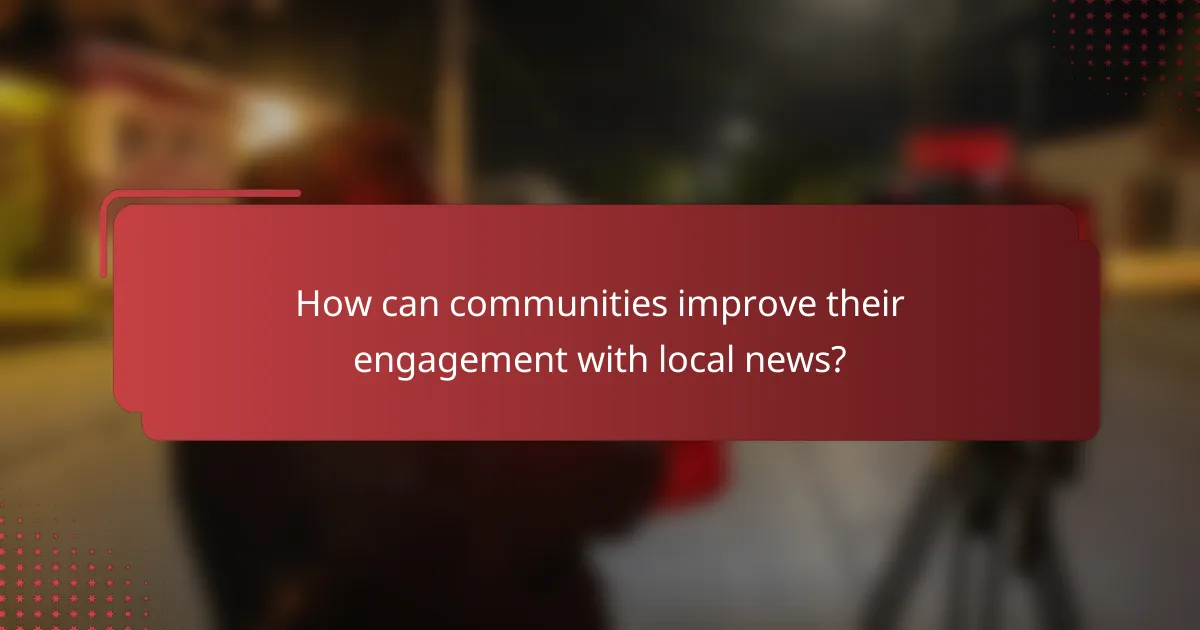
How can communities improve their engagement with local news?
Communities can improve their engagement with local news by actively participating in discussions and providing feedback. This can be done through attending local news events, town hall meetings, and workshops. Utilizing social media platforms to share news stories and opinions can also enhance engagement. Collaborating with local news outlets to create community-driven content fosters a sense of ownership. Research from the Pew Research Center shows that communities with higher interaction levels report increased trust in local news. Engaging with local journalists and supporting their work can lead to more relevant news coverage. Building partnerships with schools and organizations can further expand outreach efforts.
What strategies can be implemented for better interaction with traditional media?
Engaging effectively with traditional media requires several strategic approaches. First, establishing strong relationships with journalists is essential. This can be achieved through regular communication and providing valuable information. Second, crafting clear and compelling press releases can enhance visibility. Press releases should focus on newsworthy events relevant to the community. Third, hosting media events can foster direct interaction. These events allow for personal connections and detailed discussions about local issues. Fourth, utilizing social media to amplify traditional media coverage can increase reach. Sharing articles and interviews on platforms like Facebook and Twitter maximizes audience engagement. Fifth, providing exclusive content or interviews can attract media interest. Unique stories or insights can make a significant impact. Finally, monitoring media coverage and providing feedback can improve future interactions. This approach helps build a collaborative relationship with media outlets.
How can feedback mechanisms enhance the relationship between media and communities?
Feedback mechanisms can enhance the relationship between media and communities by facilitating two-way communication. This interaction allows communities to express their needs and concerns. Media outlets can then tailor their content to better serve these needs. Feedback can come from surveys, social media, or community meetings. This responsive approach builds trust and fosters engagement. According to a study by the International Journal of Communication, effective feedback mechanisms improve audience satisfaction and loyalty. Enhanced community involvement leads to more relevant news coverage. Ultimately, this dynamic strengthens the media’s role as a vital community resource.
What role does education play in fostering media literacy among community members?
Education plays a crucial role in fostering media literacy among community members. It equips individuals with the skills to critically analyze media content. Through structured curricula, education helps people discern credible sources from misinformation. Programs focusing on media literacy enhance understanding of media’s influence on public perception. In Malawi, initiatives targeting youth and adults have shown improved critical thinking regarding local news. Research indicates that communities with higher media literacy are better engaged in civic activities. This engagement leads to informed decision-making and active participation in local governance. Therefore, education is fundamental in building a media-literate society.
What best practices can be adopted for effective community engagement?
Effective community engagement requires active listening and clear communication. Engaging with community members through surveys and feedback sessions helps identify their needs. Utilizing local media platforms fosters trust and disseminates information effectively. Regularly hosting community events encourages participation and strengthens relationships. Collaborating with local organizations amplifies outreach efforts and resources. Transparency in decision-making builds community confidence and ownership. Employing social media can enhance interaction and broaden reach. Monitoring and evaluating engagement strategies ensures continuous improvement.
How can local events be utilized to promote engagement with traditional media?
Local events can promote engagement with traditional media by providing content for news coverage. These events often attract community participation, creating stories that traditional media outlets find newsworthy. Coverage of local events can enhance visibility for both the event and the media outlet. Engaging local personalities or influencers at these events can further attract media attention. For instance, local festivals often receive extensive coverage, showcasing cultural significance and community involvement. This coverage can lead to increased readership and viewership for traditional media, fostering a stronger connection with the community.
What are some successful case studies of community engagement in Malawi?
Successful case studies of community engagement in Malawi include the “Community-Led Total Sanitation” (CLTS) initiative. This program empowers communities to improve sanitation and hygiene practices. It has led to a significant increase in the number of households with latrines. Reports indicate that over 2,000 villages have been declared open defecation free through this initiative.
Another example is the “Malawi Social Action Fund” (MASAF), which involves communities in local development projects. MASAF has funded various infrastructure projects like schools and roads. Community members actively participate in planning and implementation, ensuring their needs are met.
The “Farmers’ Union of Malawi” also showcases effective community engagement. This organization supports smallholder farmers through training and resources. It has improved agricultural productivity and food security in rural areas.
These case studies demonstrate the effectiveness of community involvement in addressing local challenges in Malawi.
The main entity of the article is local news trends in Malawi, particularly focusing on the influence of traditional media on community engagement. The article outlines the shift towards digital media consumption while highlighting the enduring significance of traditional media forms such as radio and newspapers. It discusses how these media platforms shape public perception, foster community engagement, and face challenges like misinformation and limited access. Key opportunities for enhancing local news engagement through technology, partnerships, and community involvement are also explored, emphasizing the importance of education and feedback mechanisms in building a media-literate society.
